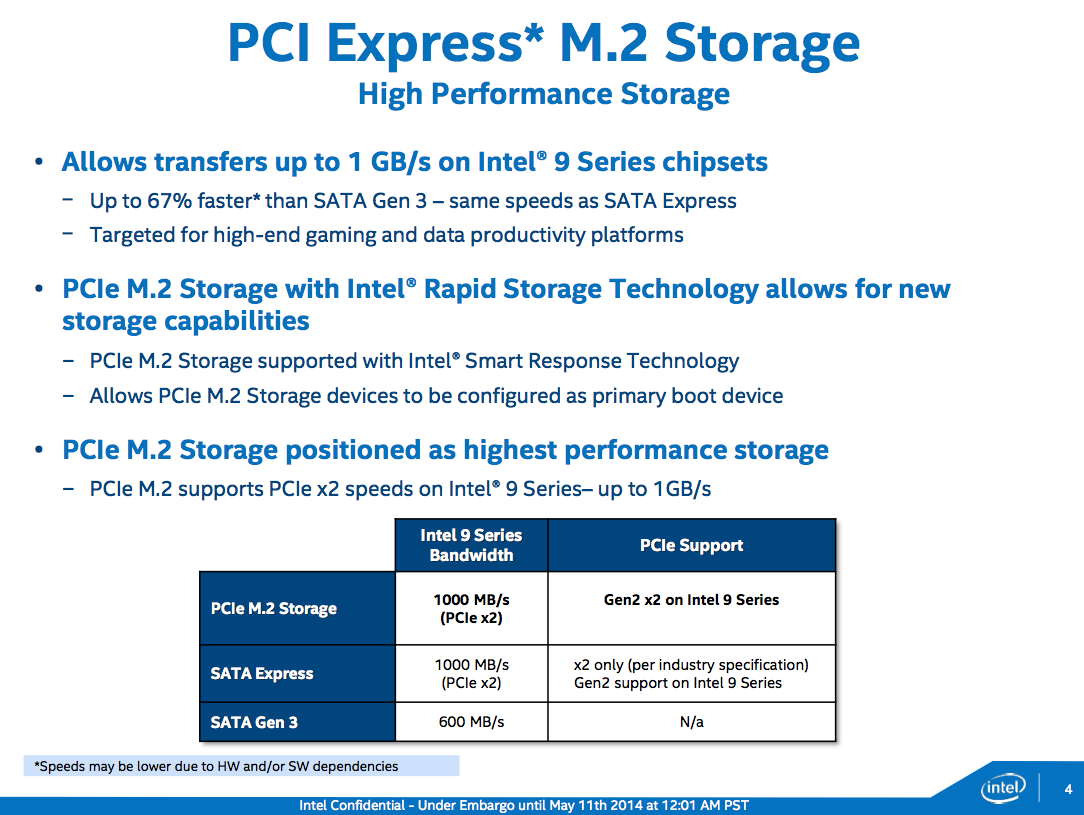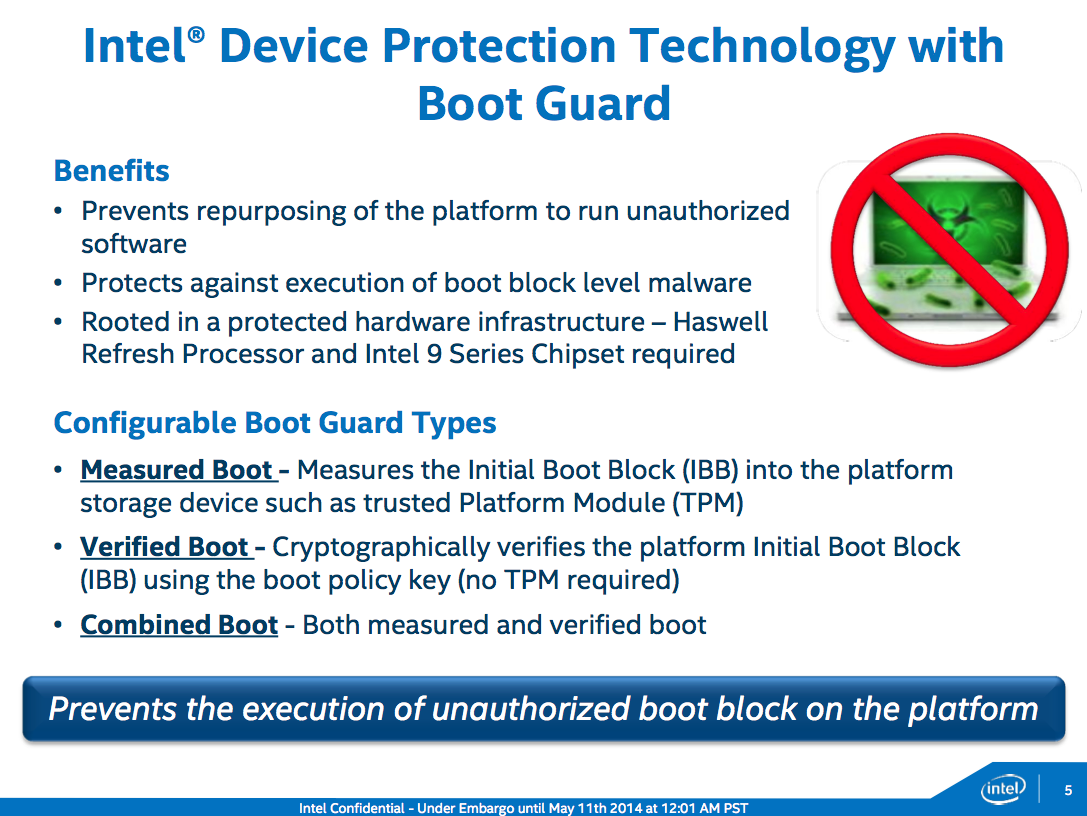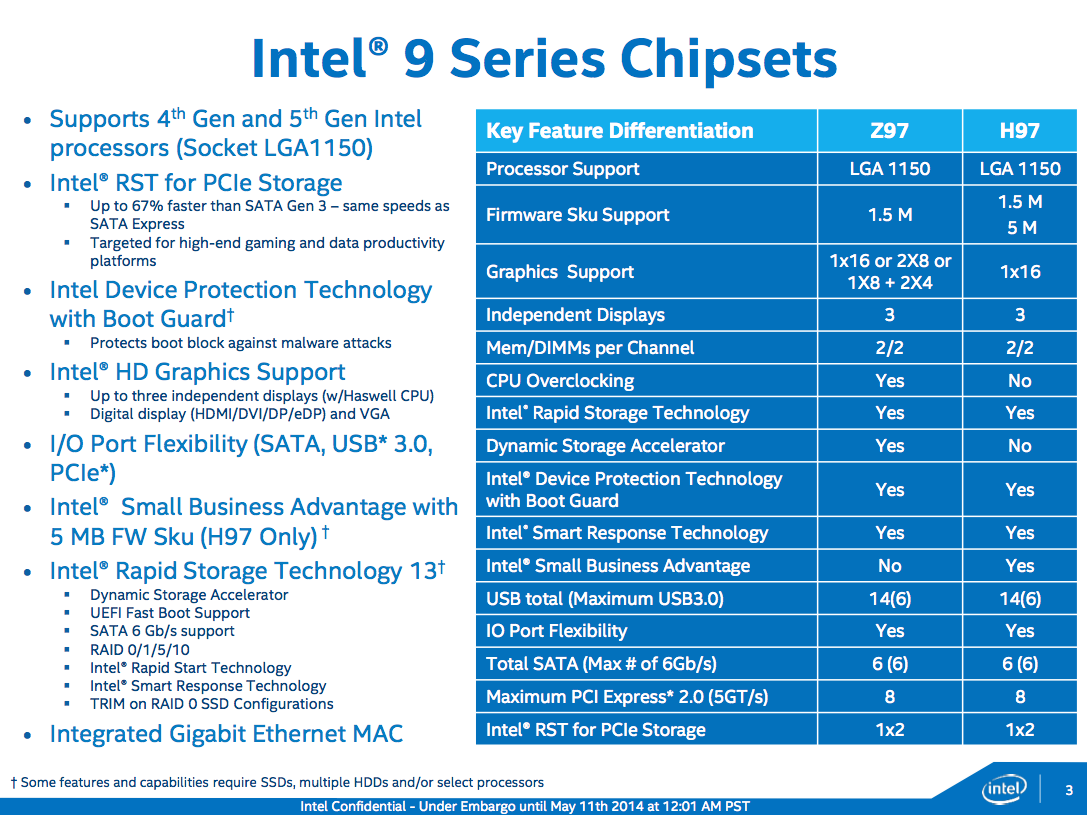Intel's chipsets improve every year in a methodical and predictable way, though the number of slight variations available can be just as confusing as the company's unendingly-segmented CPU lineup. The new 9-series chipsets take everything that was present in the previous 8-series chipsets and stacks a bit more on top of them. Today Intel is talking specifically about the Z97 and H97 variants of the chipset (both are intended for high-end desktops) but most of the capabilities should be available in all desktop and mobile versions. The primary difference between these two is that Z97 supports processor overclocking when paired with an unlocked
Intel CPU, while H97 does not.
Chipsets are the glue that holds your computer together, and they handle the bulk of the communication between your CPU, hard drive, and any external peripherals. The 9-series chipsets offer most of the same connectivity options as the preceding 8-series chipsets: a total of 14 USB ports (up to six of those can be USB 3.0), up to six SATA III ports, an integrated gigabit Ethernet controller, and a total of eight PCI Express 2.0 lanes for connectivity to other peripherals like Wi-Fi adapters and SSDs (more on that in a moment).
As in the previous-generation chipsets, the CPU handles some of the heavy lifting in situations where fast communication and low latency are important. Standard Haswell desktop CPUs include 16 PCI Express 3.0 lanes for communication with dedicated GPUs, a DDR3-1600 memory controller, and an integrated GPU that will drive up to three displays simultaneously. Broadwell should be substantially similar. Support for DDR4 memory won't come to Intel's consumer CPUs until Skylake, the follow-up to Broadwell, so don't believe those rumors about Apple (or anyone else) including DDR4 in its MacBooks this year.

Enlarge / M.2 drives are first-class citizens now.
Intel
The new features in 9-series chipsets focus on speeding up your storage, whether you've got a fast SSD or a cheaper hybrid drive. The new chipsets now support the M.2 storage specification for small-form-factor SSDs, and the chipsets use two PCI Express lanes to give the drives up to 1GB per second of bandwidth. This is a nice increase from the 600MB per second available to SATA III drives. A handful of PC OEMs are already shipping products that use PCI Express-connected storage rather than mSATA for their SSDs, and you can see our 2013 MacBook Air review for the kinds of speed increases it can enable for modern drives. This addition is going to be especially useful for Ultrabooks and mini desktops like the NUC, but we wouldn't be surprised to see M.2 connectors show up on more full-size motherboards alongside the usual SATA ports. For motherboards with a little more space, OEMs can use two PCI Express lanes can also be used to enable one of the different types of SATA Express ports that can use the faster 1GB per second speeds.

Enlarge / The Smart Response SSD caching feature is being tweaked to support hybrid drives that combine a spinning HDD and flash memory into the same package.
Intel
Next, Intel's Smart Response Technology (SRT) feature has received an upgrade. SRT allows you to use a small, solid-state cache that's 16GB or larger in size alongside a traditional mechanical hard drive to speed up launch times for your most frequently-used applications while providing a larger, cheaper pool of storage than a regular solid-state drive. Previously, the feature required separate solid-state and mechanical hard drives connected to separate connectors. Now, SRT supports hybrid hard drives with integrated flash storage, obviating the need for different drives. PCs can also use a single SSD cache to support both SRT and the separate-but-related Rapid Start Technology, which uses the SSD cache to speed up hibernation by dumping the contents of RAM to the flash memory rather than the HDD.
The last new feature is an odd fit for a desktop motherboard—Intel's newest Atom processors include something called Device Protection Technology, which (among a few other things) prevents "unauthroized boot loaders" from working on Intel-powered Android tablets. The 9-series chipsets introduce this feature to Core-powered systems with the refreshed Haswell CPUs.

Enlarge / Device Protection Technology and Boot Guard are better suited for Android devices than PCs, but they're coming to the desktop anyway.
Intel
These booting mechanisms are ostensibly included to prevent a malware-infected bootloader from damaging your system or stealing your data, but they can reduce your PC's flexibility by limiting the operating systems you can install on it. If we had to guess, we'd say that features like this and Secure Boot will continue to be optional (or, at least, disable-able) on most desktops and laptops. This feature is more likely intended to encourage development of high-end, Haswell- and Broadwell-powered Android tablets, convertibles, laptops, and desktops.
The inclusion of an Android-centric feature in a briefing about desktop motherboards really drives home where Intel's attentions are focused nowadays. Even though these chipsets include new things that will benefit both desktops and laptops, they'll be the most useful in computers where space is at a premium. Intel has been focusing on mobile devices for a few years now, prioritizing reductions in power consumption over increases in performance. Today's chipset announcement and some new overclocker-friendly processor options are meant to keep Intel's desktop users happy, but the company is still focused largely on thin-and-light laptops, convertibles, and tablets.

No comments:
Post a Comment